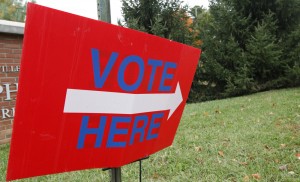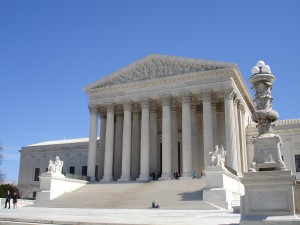The Supreme Court issued three opinions today. Read more about the decisions below.
Shelby County v. Eric H. Holder, Jr.
Docket: 12-96
Date: June 25, 2012
Read commentary and review lower court decisions related to Shelby County decision here.
 Justia Opinion Summary: The Voting Rights Act of 1965, 42 U.S.C. 1973(a), was enacted to address racial discrimination in voting. Section 2 bans any “standard, practice, or procedure” that “results in a denial or abridgement of the right of any citizen … to vote on account of race or color,” applies nationwide, and is permanent. Other sections apply to some parts of the country. Section 4 defines “covered jurisdictions” as states or political subdivisions that maintained tests or devices as prerequisites to voting and had low voter registration or turnout in the 1960s and early 1970s. Section 5 provides that no change in voting procedures can take effect in covered jurisdictions until approved by federal authorities (preclearance). The coverage formula and preclearance requirement were to expire after five years, but the Act was reauthorized. In 2006, the Act was reauthorized for an additional 25 years, but coverage still turned on whether a jurisdiction had a voting test and low registration or turnout almost 50 years ago. Shelby County, in the covered jurisdiction of Alabama, sought a declaratory judgment that sections 4(b) and 5 are facially unconstitutional. The district court upheld the Act. The D. C. Circuit affirmed. A 5-4 Supreme Court reversed, finding Section 4 unconstitutional. Its formula may not be used to require preclearance. States have broad autonomy in structuring their governments and pursuing legislative objectives; the Tenth Amendment reserves to states “the power to regulate elections.” There is a “fundamental principle of equal sovereignty” among the states. The Voting Rights Act departs from those principles by requiring states to request federal permission to implement laws that they would otherwise have the right to enact and execute. The Act applies to only nine states (and additional counties). In 1966, the departures were justified by racial discrimination that had “infected the electoral process in parts of our country for nearly a century” so that the coverage formula was rational in practice and theory. Nearly 50 years later, “things have changed dramatically.” Voter turnout and registration rates in covered jurisdictions approach parity; blatantly discriminatory evasions of federal decrees are rare. Minority candidates hold office at unprecedented levels. Congress, if it is to continue to divide the states, must identify jurisdictions to be singled out on a basis that makes sense under current conditions. Data compiled by Congress before reauthorizing the Act did not show anything like the pervasive, rampant discrimination found in covered jurisdictions in 1965. Congress reenacted the formula based on 40-year-old facts with no logical relation to the present day.
Justia Opinion Summary: The Voting Rights Act of 1965, 42 U.S.C. 1973(a), was enacted to address racial discrimination in voting. Section 2 bans any “standard, practice, or procedure” that “results in a denial or abridgement of the right of any citizen … to vote on account of race or color,” applies nationwide, and is permanent. Other sections apply to some parts of the country. Section 4 defines “covered jurisdictions” as states or political subdivisions that maintained tests or devices as prerequisites to voting and had low voter registration or turnout in the 1960s and early 1970s. Section 5 provides that no change in voting procedures can take effect in covered jurisdictions until approved by federal authorities (preclearance). The coverage formula and preclearance requirement were to expire after five years, but the Act was reauthorized. In 2006, the Act was reauthorized for an additional 25 years, but coverage still turned on whether a jurisdiction had a voting test and low registration or turnout almost 50 years ago. Shelby County, in the covered jurisdiction of Alabama, sought a declaratory judgment that sections 4(b) and 5 are facially unconstitutional. The district court upheld the Act. The D. C. Circuit affirmed. A 5-4 Supreme Court reversed, finding Section 4 unconstitutional. Its formula may not be used to require preclearance. States have broad autonomy in structuring their governments and pursuing legislative objectives; the Tenth Amendment reserves to states “the power to regulate elections.” There is a “fundamental principle of equal sovereignty” among the states. The Voting Rights Act departs from those principles by requiring states to request federal permission to implement laws that they would otherwise have the right to enact and execute. The Act applies to only nine states (and additional counties). In 1966, the departures were justified by racial discrimination that had “infected the electoral process in parts of our country for nearly a century” so that the coverage formula was rational in practice and theory. Nearly 50 years later, “things have changed dramatically.” Voter turnout and registration rates in covered jurisdictions approach parity; blatantly discriminatory evasions of federal decrees are rare. Minority candidates hold office at unprecedented levels. Congress, if it is to continue to divide the states, must identify jurisdictions to be singled out on a basis that makes sense under current conditions. Data compiled by Congress before reauthorizing the Act did not show anything like the pervasive, rampant discrimination found in covered jurisdictions in 1965. Congress reenacted the formula based on 40-year-old facts with no logical relation to the present day.

 Justia Summary: Since the Court’s 2003 decision,
Justia Summary: Since the Court’s 2003 decision,